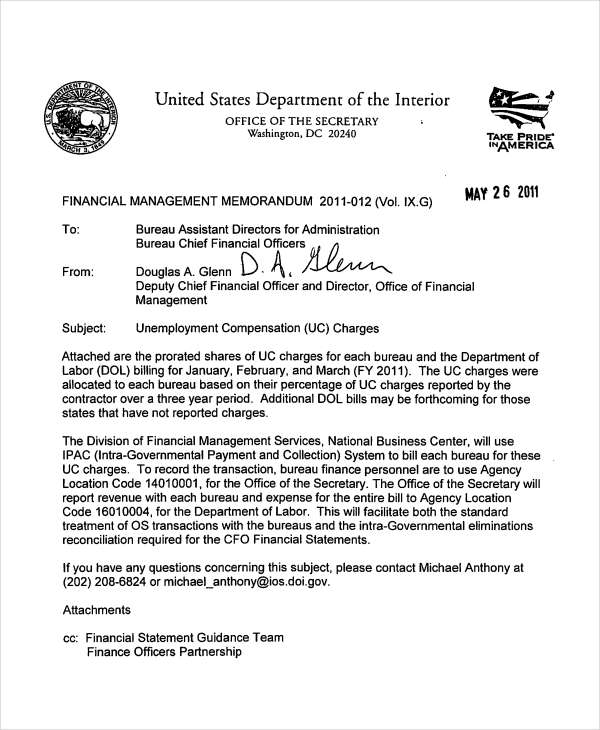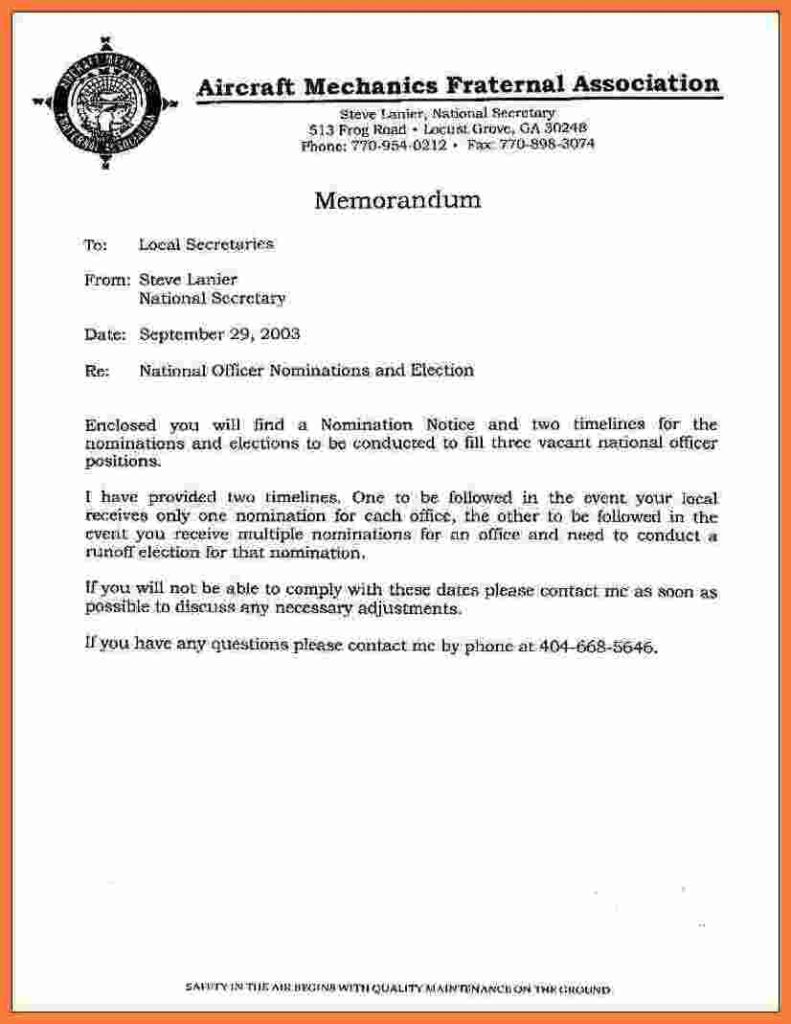A memorandum or memo has a distinct structure that makes this style of paper stand out from other forms of writing explicitly because of different memo’s purposes as a type of formal writing. Such a document usually identifies a problem and draws a specific attention of concerned parties to make recipients aware of problems, establishing a particular need for an issue to be addressed. However, all examples of memos have to provide solutions to addressed problems. Therefore, an analysis of components that make up a memorandum is presented to show variations and possible structure of memo examples.
General Aspects
Memo examples, being a short version of a memorandum, are concise written documents used within organizations to share information, make announcements, or provide directives. Basically, such samples of documents are directed toward employees, departments, or management heads and follow a standardized format, including sections like To, From, Date, and Subject. In this case, a manager might send a memo example to all employees to announce a new remote work policy. Firstly, this document should start with a heading, such as “To: All Employees, From: Alex Freedman, HR Manager, Date: July 1, 2024, Subject: Updated Remote Work Policy.” Secondly, a body of this letter would explain policy changes, stating that employees can now work remotely up to three days a week with prior supervisor approval, and would provide details on where to find additional guidelines. Thirdly, a closing statement would urge employees to review a new policy and reach out with any questions. As a result, a manager ensures essential information is communicated clearly and efficiently, maintaining transparency and keeping everyone in an organization informed and aligned. For reference, employees might need examples of DSM 5 APA citation. In turn, a typical length of memo examples depends on a content depth at different academic levels, while general guidelines include:
High School
- Length: 1-2 pages
- Words: 250-500 words
- Characteristics: Short and straightforward, focusing on clarity and brevity.
College
- Length: 1-3 pages
- Words: 250-500 words
- Characteristics: More detailed, including additional background information and explanations, while still being concise.
University
- Length: 2-4 pages
- Words: 500-1,000 words
- Characteristics: More comprehensive, with relevant details and some analysis, providing a clear and structured communication.
Master’s
- Length: 3-5 pages
- Words: 750-1,250 words
- Characteristics: Detailed and analytical, offering in-depth information, background, and a well-supported argument or recommendation.
Ph.D.
- Length: 4-8 pages
- Words: 1,000-2,000 words
- Characteristics: Highly detailed and scholarly, incorporating extensive research, data, and analysis, supported by academic references and detailed findings.
Types
| Memo Type | Purpose |
|---|---|
| Informational | To provide information about a specific topic to recipients. |
| Request | To request information or action from recipients. |
| Confirmation | To confirm discussions or agreements that have taken place. |
| Periodic Report | To provide regular updates on specific topics or projects. |
| Recommendation | To suggest a course of action or propose an idea. |
| Problem-Solving | To address a specific issue and propose solutions. |
| Persuasive | To persuade recipients to take a particular action or adopt a viewpoint. |
| Policy | To communicate new or updated policies and procedures. |
| Social or Event | To inform about upcoming events or social activities. |
| Directive | To give instructions or orders to recipients. |
| Business | To communicate formal messages within a business context, often related to operations, strategy, or internal affairs. |
| Research | To share findings, progress, or plans related to a research project. |
| Professional | To communicate professionally within a corporate environment and address managerial or strategic issues. |
| Legal | To provide legal analysis and advice on a specific issue within law firms or legal departments. |
| Advisory | To offer advice or guidance on a particular issue or situation. |
Basic Format
| Section | Content | Example |
|---|---|---|
| To | Recipient(s) | “All Students” |
| From | Sender | “Principal” |
| Date | Date when this letter is written | “July 1, 2024” |
| Subject | Brief summary of a topic | “Upcoming School Event” |
| Opening | Purpose | “Hello. There will be a school event on our campus on July 10, 2024.” |
| Body | Main content | “Attendance is mandatory. Please see an attached schedule for details.” |
| Closing | Final remarks or call to action | “Thank you for your attention.” |
| Sources (Optional) | List of sources used and cited in MLA, APA, Chicago/Turabian, Harvard, or other formats. | None |
| Attachments (Optional) | List of attached documents | “Schedule of Events” |
| Using this format, a short memo example might be: To: All Students From: Principal Date: July 1, 2024 Subject: Upcoming School Event Hello. Hello. There will be a school event on our campus on July 10, 2024. Attendance is mandatory. Please see an attached schedule for details. Thank you for your attention. Sincerely, Principal Schedule of Events (File or Link) | ||
Key Parts of a Memo
There are two main parts in a memorandum: Heading and Body. Basically, a heading segment is usually a first part of any memo example. In this case, the information contained in a heading segment is usually related to a memorandum’s origin, content, and desired audience (Falon, 2020). Moreover, a body of such a document usually follows just after a heading segment, and this part contains a detailed but brief presentation of problems, solutions, and recommendations. Hence, each of these elements has general formats. In turn, writers organize their documents in slight variations to general formats to accommodate institution-specific memo structures, achieving an intended purpose of that particular memorandum.

Headings
A heading segment contains two distinct parts: a Company’s Header and a Descriptive Section that includes information concerning recipients, a memo’s origin, and hints toward body paragraphs. Therefore, company headers are usually institution-specific.
Purpose
Each word in headings has a specific purpose. For
Position
Company headers usually identify institutions to which memo examples belong. For example, headers, depending on the institution’s preferred formats, may either be at the top left, the center, or top right of documents (Bardach & Patashnik, 2024). However, institutional headers used in memo examples are usually shortened versions of headers used in formal letters. A company’s header usually lacks detailed contact information and address but instead just contains a specific logo, and, in some cases, a short caption line below it. Choices of how headers will look fall solely on institutions, while they use memorandums for internal communication. However, since companies have many departments at different physical locations, writers may include logos to show institutional affiliation.
Structure
Descriptive segments consist of “To,” “From,” “Date,” and “Subject.” In particular, it aligns to the left margin. For instance, the word “To” provides platforms for listing all the names of intended recipients in memo examples (Falon, 2020). These initials provided usually include first and last names of recipients together with titles of departmental affiliation. In cases where all the recipients are aware of each other’s identity, for example, within a department of fewer than ten employees, members use the first initial followed by the last name (Best, 2024). Furthermore, writers list recipients either alphabetically or according to ranks in institutions, although it is better to use rank arrangements. Additionally, senders may use departmental sorting of names.
Sample Heading of a Memo
- To: Recipients
- From: Alex Freedman
- Date: July 1, 2024
- Subject: Guides on Memo Samples
At times, writers may not list all the recipients’ names in the “To” position due to a large number of recipients. To remedy this challenge, the words “See distribution list” are filled in the “To” area, and a distribution list is written at the end of memorandum samples (Falon, 2020). “From” provides a specific area for a listing of author’s or authors’ names accompanied by corresponding initials. Hence, a particular ordering of names for multiple authors is similar to that for multiple recipients. Moreover,
Body of Memo Examples
To write their memo examples, people clearly state their purposes in an opening section, provide detailed information in an organized manner, include any necessary attachments, and conclude with a call to action or summary, ensuring a professional tone is maintained. For example, a typical body of a good memorandum elaborates further on subject topics identified in heading segments (Enquist et al., 2022). In particular, a memo’s body includes four major parts: introduction, statement of facts, argument, and conclusion.
Introduction
An introduction part works to establish a memorandum’s context. Eventually, to start a memo example, people begin with a clear and concise statement of its purpose, such as “I am writing to update you on recent developments in our project timeline and its necessary next steps.” A basic introductory paragraph includes specific purposes and any additional information that is relevant to help recipients to remember exact events referred to in a letter, for example, reference numbers to a letter and a brief outline of a remaining part of a body (Best, 2024). Hence, depending on an intended memo plan style chosen, a typical length of an introduction paragraph changes accordingly. For a one-page memorandum, paragraphs should be roughly 4-6 sentences long. In turn, some samples of opening sentences for writing memo examples include:
- I am writing to inform you that we will see upcoming changes to our office hours, which will take effect in the next month, and to outline particular reasons behind this adjustment.
- This memo example is to notify all staff of a new company policy regarding remote work, including necessary procedures for requesting remote work days and the expected benefits of this initiative.
- Please be advised that there will be a mandatory meeting for all employees next Monday to discuss our latest updates on our strategic initiatives and upcoming projects.
- We are excited to announce a launch of our new employee wellness program, which includes a variety of health and fitness activities designed to promote overall well-being among our staff.
- This memorandum example serves to update you on a status of an ongoing project in our marketing department, highlighting key milestones achieved so far and outlining the next steps in our project timeline.
- I would like to bring to your attention recent developments in our data security protocols, which are critical to safeguarding our company’s sensitive information and ensuring compliance with industry standards.
- We are pleased to inform you that our company has achieved its quarterly financial goals, defining our revenue targets and demonstrating strong performance across all departments.
- This message is intended to provide guidelines for an upcoming audit process, detailing all the steps that each department needs to take to prepare for this check and ensure a smooth and efficient review.
- We need to address recent changes in our supplier agreements and their implications for our operations, including adjustments to delivery schedules and cost structures.
- Please note the following instructions and recommendations for submitting your annual performance reviews, including key deadlines and tips for completing this process effectively and accurately.
Statement of Facts
A second part of a memo or statement of facts illustrates specific points related to problems or issues addressed by memorandum examples. Providing evidence, data, cases, and valid arguments elaborates more on its subject.
Argument
An argument part provides evidence and explains an actual relevance of the facts mentioned in previous sections. Besides, this feature shows relations between suggested solutions and problems addressed.
Conclusion
Conclusions summarize an entire memo’s content. Basically, summaries may include stating recommendations or specific courses of action for its recipients. Writers take this situation in a specific case, and an indication of future actions is based on corresponding findings.

Different Structures
A typical body of memo examples can take various structures. The kind of structure taken depends on factors, such as a memo’s type and its content. Regarding its type, a lengthy memorandum has a longer and more detailed body as compared to a short memo (Bardach & Patashnik, 2024). Additionally, such documents, presenting outcomes of particular activities, might use subheadings while this feature may not be necessary for straightforward content, such as informing employees to attend meetings. Nevertheless, a memo’s body should be brief and straight to the point (Williams et al., 2018). There should be no additional statements that add no value to its content. Conclusions should be obvious to readers because of processed information. If possible, concluding segments should not be presented in long, complicated sentences (Chametzky, 2023). As such, its body holds all the subject content under discussion. In turn, a sample of a midterm memorandum for an English 101 class is provided below:
Recommendations
| Criteria | Description |
|---|---|
| Clear and Relevant Subject Line | Ensure your subject line is concise and accurately reflects a specific content. |
| Defined Purpose | State a specific purpose clearly at the beginning so that your reader understands your intent immediately. |
| Targeted Audience | Address your letter to an appropriate audience, using specific names and titles if necessary. |
| Structured Format | Use a standard memo example format with sections, such as To, From, Date, Subject, Body, and Closing. |
| Concise and Relevant Content | Include only essential information, avoiding unnecessary details and jargon. |
| Organized Information | Use headings, bullet points and subpoints, or numbered lists to organize your content logically and make it easy to follow. |
| Actionable Items | Clearly outline any required actions or next steps, specifying who needs to do what and by when. |
| Professional Tone | Maintain a professional, non-biased, and respectful tone throughout your letter, appropriate for both an organizational culture and recipients. |
| Attachments | Mention any attached documents or materials that support a letter’s content and ensure they are included. |
| Contact Information | Provide sender’s contact details or instructions on how to get further information or clarification. |
| Proofreading and Accuracy | Review a complete document for spelling, grammar, and factual accuracy to ensure it is error-free and credible. |
| Clarity and Readability | Use clear and simple language, short sentences, and paragraphs to enhance readability. |
| Consistency | Ensure your memorandum example is consistent in style, tone, and format with other communications from an institution or organization. |
| Visual Appeal | Use a clean and professional layout, appropriate font size, and spacing to make a paper visually appealing and easy to read. |
| Timeliness | Send your letter in a timely manner, ensuring its information is relevant and actionable within a necessary timeframe. |
Spacing
Most memo examples are usually short one-page documents. In this case, writers organize documents to portray great readability. For instance, spacing is usually at the author’s discretion but is restricted by a few guidelines (Enquist et al., 2022). As such, there should be no spacing that holds no significance to memo examples. Further on, one should not place unnecessary spacing to fill pages. Spacing should permanently break body paragraphs into logical sections for readability (Enquist et al., 2022). Writers cannot have memorandum examples in one single paragraph. Moreover, senders should use a suitable font and font size to enhance readability. Thus, an overall presentation of a memorandum is crucial, resulting in a document’s readability.
Common Mistakes
- Lack of Clarity in a Subject Line: A vague or unclear subject line can confuse recipients about a memo example’s purpose.
- Unclear Purpose: Not stating a purpose at the beginning can lead to confusion.
- Too Much Information: Overloading a document with excessive details can overwhelm readers.
- Poor Organization: A disorganized letter can be hard to follow.
- Inappropriate Tone: Using an overly casual or formal tone can be off-putting.
- Lack of Proofreading: Typos, grammatical errors, and incorrect information can undermine a document’s credibility.
- Not Addressing a Right Audience: Sending a letter to a wrong audience or not considering people’s needs can render it ineffective.
- Missing or Incorrect Details: Omitting key information or providing incorrect details can cause misunderstandings.
- No Call to Action: Failing to specify what action is needed can lead to an ignorance of a letter.
- Ignoring Formatting Conventions: Ignoring standard memo formatting, such as To, From, Date, Subject, Body, and Closing, can make a paper look unprofessional.
Summing Up
Discussion segments of a memorandum’s structure should provide adequate information for anyone who wants to believe their messages effectively. Basically, people need to remember that all memo examples have two main parts: Heading and Body. Other aspects of each of these parts have been scrutinized above. In turn, employers and employees should master memo writing as a skill, as they can use such a piece of knowledge in various institutional settings.
References
Bardach, E., & Patashnik, E. M. (2024). A practical guide for policy analysis: The eightfold path to more effective problem solving. Sage.
Best, A. (2024). Examples and explanations for evidence. Aspen Publishing.
Chametzky, B. (2023). Writing memos: A vital classic grounded theory task. European Journal of Humanities and Social Sciences, 3(1), 39–43. https://doi.org/10.24018/ejsocial.2023.3.1.377
Enquist, A., Oates, L. C., & Francis, J. (2022). Just writing: Grammar, punctuation, and style for the legal writer. Aspen Publishing.
Falon, P. H. (2020). How to organize and write a legal memorandum. Aspen Publishing.
Williams, J. A., Schutts, J., Gallamore, K., & Amaral, N. (2018). Assessment of memorandum writing in a quantitative business context. Business and Professional Communication Quarterly, 82(1), 38–52. https://doi.org/10.1177/2329490618798606


